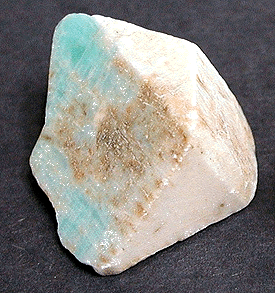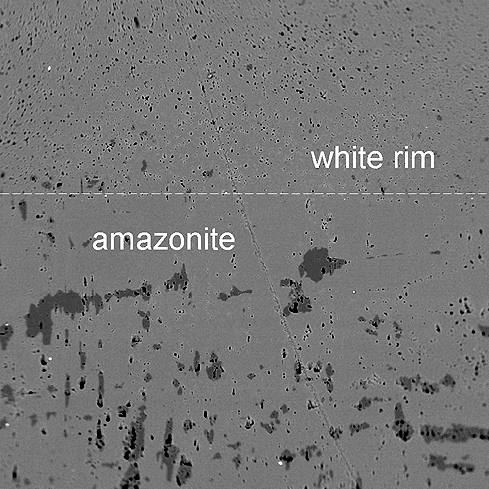|
(revised 05/02/2003)
| |
|
John S. White asks: According to what scant literature I can find on the subject here in my own library it seems to be generally accepted that the white overgrowths often seen on amazonite are albite, not microcline. At the Rochester Symposium I asked Dan Kile if he knows anything about this, since he lives and collects extensively in Colorado. He said that he has a faint recollection that the late Gene Foord had done something with this and was of the opinion that the white overgrowths are microcline, but Gene never published his findings. Do you or your readers have anything to contribute to this issue? Dan Kile replies: Regarding albite overgrowths, my memory (surprisingly) was pretty much correct. Gene Foord had done some work on this stuff, and came to the conclusion that: (1) random overgrowths can be either albite or microcline, and (2) oriented overgrowths are a microcline (k-spar) phase. This was briefly written up in the Minerals of Colorado (Eckel et al, 1997) on p. 322. Citations to Blasi (1983, 1984) and Foord (1986) are given, but they may not pertain to the overgrowths. I have not had time to check these citations. In any event, it seems that at least one investigator has ruled out albite as an oriented overgrowth, which I would agree with. David London replies: We examined one amazonite crystal with white margins, similar to the 3-cm crystal shown in Figure 1, from Otjimbingwe, Namibia. The backscattered electron image (Fig. 2, 1580 x 1580 um) shows that the white rim is rather porous K-feldspar (we presume microcline) over slightly perthitic amazonite. Note that albite lamellae are absent in the narrow region adjacent to the white rim. Elsewhere on this crystal, where amazonite cores give way to white rims, the white rimming material is always K-feldspar (in all directions, corresponding to different crystallographic zones). This may characterize the amazonite from Otjimbingwe, but I would be grateful if someone would contribute similar images (or material that we will image) of the classic white-rimmed amazonite from Colorado localities (i.e., to confirm Dan Kyle†s recollection from Gene Foord that these are K-feldspar, too).
Figure 1.
Figure 2. Robert F. Martin replies: The white caps that coat certain faces on amazonite perthite crystals in certain pockets consist of single-phase, non-perthitic microcline that is virtually lead-free (and thus white). We used this material for a refinement of the crystal structure of well-ordered microcline. The overgrowth was deposited from a fluid phase in the field of stability of microcline. In other words, this alkali feldspar did not have a monoclinic antecedent. Blasi, A., Brajkovic, A., De Pol Blasi, C., Foord, E.E., Martin, R.F. & Zanazzi, P.F. (1984): Structure refinement and genetic aspects of a microcline overgrowth from Pikes Peak batholith, Colorado, U.S.A. Bull. Min»ral. 107, 411-422. I hope that this answers your question. Wallace Kleck replies: Perthitic K-feldspar from the pockets of the Elizabeth R mine (Pala district; formally the Ocean View Mine) have similar 'white' rims (some rims are up to a cm thick); the crystals have interiors of mixed orthoclase and low-microcline, etched outer zones (remnant plagioclase with an enclosing rim of ? remaining) and finally covered by a white, non-perthitic (or crypto-perthitic) medium microcline. Gene (Foord) first pointed them out to me back in ~1997. All identifications are by the powder x-ray, 3-peak method; I am in the process of redoing these with an internal standard; more if you wish as I complete the study. George P. Zaraisky replies: We examined similar white rims around blue-green amazonite crystals from the pegmatoid bodies of Orlovka and Etyka tantalum deposits, Eastern Transbaikalia, Russia. These rims have thickness of 1-10 mm. In all cases it is white microcline. I suppose:
2) it is the pseudomorphic production rather than the "overgrowth deposited from a fluid phase. | |


